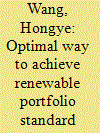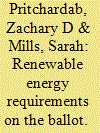|
|
|
Sort Order |
|
|
|
Items / Page
|
|
|
|
|
|
|
| Srl | Item |
| 1 |
ID:
183559


|
|
|
|
|
| Summary/Abstract |
The implementation of renewable portfolio standard (RPS) policy may bring some adverse effects when the region lacks of the capacity to cope with policy stresses. This paper proposes an analytical framework of adaptive capacity index to RPS policy (ACI-RPS) and apply it to evaluate the provincial adaptive capacity to RPS in China over time. The results show that the ACI-RPS in China displayed an increasing trend but declined slightly in 2017 due to the technical bottlenecks. There was a wide disparity in ACI-RPS across the provinces in China, with eastern provinces having the highest but northeastern provinces having the lowest scores. These results indicate that provincial RPS targets need to be set with reference to their adaptive capacity and local energy status. Specifically, more ambitious targets may be assigned to eastern, southern, and northern provinces. It is concluded that the promotion of power grid construction and the acceleration of power marketization are two effective ways to further improve the capacity to cope with RPS policy of a region.
|
|
|
|
|
|
|
|
|
|
|
|
|
|
|
|
| 2 |
ID:
113423


|
|
|
|
|
| Publication |
2012.
|
| Summary/Abstract |
This paper quantifies the relative cost-savings of utilizing a greenhouse gas emissions-weighted Clean Energy Standard (CES) in comparison to a Renewable Portfolio Standard (RPS). Using a bottom-up electricity sector model for Hawaii, this paper demonstrates that a policy that gives "clean energy" credit to electricity technologies based on their cardinal ranking of lifecycle GHG emissions, normalizing the highest-emitting unit to zero credit, can reduce the costs of emissions abatement by up to 90% in comparison to a typical RPS. A GHG emissions-weighted CES provides incentive to not only pursue renewable sources of electricity, but also promotes fuel-switching among fossil fuels and improved generation efficiencies at fossil-fired units. CES is found to be particularly cost-effective when projected fossil fuel prices are relatively low.
|
|
|
|
|
|
|
|
|
|
|
|
|
|
|
|
| 3 |
ID:
124333


|
|
|
|
|
| Summary/Abstract |
Several states have a renewable portfolio standard (RPS) and allow for biomass co-firing to meet the RPS requirements. In addition, a federal renewable fuel standard (RFS) mandates an increase in cellulosic ethanol production over the next decade. This paper quantifies the effects on local biomass supply and demand of different co-firing policies imposed on 398 existing coal-fired power plants. Our model indicates which counties are most likely to be able to sustain cellulosic ethanol plants in addition to co-firing electric utilities. The simulation incorporates the county-level biomass market of corn stover, wheat straw, switchgrass, and forest residues as well as endogenous crop prices. Our scenarios indicate that there is sufficient feedstock availability in Southern Minnesota, Iowa, and Central Illinois. Significant supply shortages are observed in Eastern Ohio, Western Pennsylvania, and the tri-state area of Illinois, Indiana, and Kentucky which are characterized by a high density of coal-fired power plants with high energy output.
|
|
|
|
|
|
|
|
|
|
|
|
|
|
|
|
| 4 |
ID:
096646


|
|
|
|
|
| Publication |
2010.
|
| Summary/Abstract |
Renewable electricity is pivotal to the medium and long-term reduction of Australia's greenhouse gas (GHG) emissions, if deep cuts in them are eventually implemented. This paper examines the effectiveness of the principal existing policies that could potentially promote the expansion of renewable electricity (RElec) in Australia: the expanded Renewable Energy Target (RET); the proposed emissions trading scheme (ETS); and the state and territory-based feed-in tariffs. We find the effectiveness of RET is severely eroded by the inclusion of solar and heat pump hot water systems; by the inclusion of 'phantom' tradable certificates; and by high electricity consumption growth. We also find that the ETS will not produce a high enough carbon price to assist most RElec technologies before 2020; and that most of the feed-in tariffs exclude large-scale RElec and will give little assistance to small-scale RElec because they are mostly net tariffs. Unless there is a major revision of its RElec policy mechanisms, Australia will fail to reach its renewable electricity target and in particular will fail to build up its solar generation capacity which could be a major source of future deep cuts in the country's electricity generation emissions.
|
|
|
|
|
|
|
|
|
|
|
|
|
|
|
|
| 5 |
ID:
097480


|
|
|
|
|
| Publication |
2010.
|
| Summary/Abstract |
Renewable electricity is pivotal to the medium and long-term reduction of Australia's greenhouse gas (GHG) emissions, if deep cuts in them are eventually implemented. This paper examines the effectiveness of the principal existing policies that could potentially promote the expansion of renewable electricity (RElec) in Australia: the expanded Renewable Energy Target (RET); the proposed emissions trading scheme (ETS); and the state and territory-based feed-in tariffs. We find the effectiveness of RET is severely eroded by the inclusion of solar and heat pump hot water systems; by the inclusion of 'phantom' tradable certificates; and by high electricity consumption growth. We also find that the ETS will not produce a high enough carbon price to assist most RElec technologies before 2020; and that most of the feed-in tariffs exclude large-scale RElec and will give little assistance to small-scale RElec because they are mostly net tariffs. Unless there is a major revision of its RElec policy mechanisms, Australia will fail to reach its renewable electricity target and in particular will fail to build up its solar generation capacity which could be a major source of future deep cuts in the country's electricity generation emissions.
|
|
|
|
|
|
|
|
|
|
|
|
|
|
|
|
| 6 |
ID:
171478


|
|
|
|
|
| Summary/Abstract |
Renewable energy electricity, such as photovoltaic (PV) power generation, has the benefits of strengthening energy security, addressing climate change, reducing air pollution, etc., but there are some impediments to deployment of renewable energy electricity: higher costs than fossil fuels, intermittent energy production, site constraints, etc. Korea changed its renewable energy electricity support systems from feed-in tariff (FIT) to a renewable portfolio standard (RPS) in 2012. This study evaluates FIT versus RPS in terms of the time to reach grid parity for PVs. Using a learning curve model, we calculate the learning rate of PV power generation during the FIT and RPS periods. We find that the PV learning rate during the RPS period was 18.44%, much higher than that during the FIT period, −0.28%, and R2 is 0.9861 and 0.7346 in the RPS and FIT periods, respectively. Using the calculated learning rate in the RPS period, we also predict that grid parity for PVs is expected in 2025 in Korea.
|
|
|
|
|
|
|
|
|
|
|
|
|
|
|
|
| 7 |
ID:
162934


|
|
|
|
|
| Summary/Abstract |
Allocating the Renewable Portfolio Standard (RPS) targets among provinces in an economically viable and fair way is the first critical step to implementing the RPS policy in China. To explore this issue, a cost minimizing model was proposed and applied in this paper. The least-cost 2018 – 2020 RPS target allocation scheme for 29 provinces and regions in China was obtained. The efficiency and equity of the RPS target allocation scheme published by China National Energy Administration in 2018 was compared with the obtained least-cost scheme and an equal allocation scheme referring to the practice in countries with only national RPS target from three aspects – energy, environment and economy. The results showed that: (1) the least-cost scheme can reduce the total cost by 3% while increasing the distribution inequity of non-hydro renewable electricity consumption measured by the Gini coefficient by 343% (112% if hydro is included); (2) the equally-allocated scheme did not show a significant advantage in equity over the government published scheme but increased the cost. Based on the results, the possibility of adopting a national renewable energy certificates trade market to reduce the cost while maintaining the equity has been discussed, and the relevant policy suggestions have been proposed.
|
|
|
|
|
|
|
|
|
|
|
|
|
|
|
|
| 8 |
ID:
125803


|
|
|
|
|
| Publication |
2013.
|
| Summary/Abstract |
This paper analyses the potential of renewable energy for power generation and its energy, environmental and economic implications in Pakistan, using a bottom up type of long term energy system based on the MARKAL framework. The results show that under a highly optimistic renewable portfolio standard (RPS) of 80%, fossil fuel consumption in 2050 would be reduced from 4660 PJ to 306 PJ, and the GHG emissions would decrease from 489 million tons to 27 million tons. Nevertheless, price of the electricity generation will increase significantly from US$ 47/MWh under current circumstances (in the base case) to US$ 86/MWh under RPS80. However the effects on import dependency, energy-mix diversity, per unit price of electricity generation and cost of imported fuels indicate that, it may not be desirable to go beyond RPS50. Under RPS50 in 2050, fuel consumption of the power sector would reduce from 21% under the base case to 9% of total fossil fuels supplied to the country. It will decrease not only GHG emission to 170 million tons but also will reduce import dependency from 73% under the base case to 21% and improve energy diversity mix with small increase in price of electricity generation (from US$ 47/MWh under the base case to US$ 59/MWh under RPS 50).
|
|
|
|
|
|
|
|
|
|
|
|
|
|
|
|
| 9 |
ID:
104925


|
|
|
|
|
| Publication |
2011.
|
| Summary/Abstract |
This report examines the impact of renewable portfolio standards (RPS) and cap-and-trade policy options on the U.S. electricity sector. The analysis uses the National Renewable Energy Laboratory's Regional Energy Deployment System (ReEDS) model that simulates the least-cost expansion of electricity generation capacity and transmission in the U.S. to examine the impact of a variety of emissions caps-and RPS scenarios both individually and combined. The generation mix, carbon emissions, and electricity price are examined for various policy combinations simulated in the modeling.
|
|
|
|
|
|
|
|
|
|
|
|
|
|
|
|
| 10 |
ID:
115676


|
|
|
|
|
| Publication |
2012.
|
| Summary/Abstract |
Recently enacted state renewable portfolio standards (RPSs) collectively require that U.S. electricity generation by non-hydro renewables more than double by 2025. These goals are not certain to be met, however, because many RPSs apply cost caps that alter requirements if costs exceed targets. We analyze here the 2008 Illinois RPS, which is fairly typical, and find that at current electricity prices, complete implementation will require significant decreases in renewables costs even given the continuation of federal renewables subsidies. Full implementation is possible but not assured. The statutory design raises additional concerns about unintended potential consequences. The fact that windpower and solar carveouts fall under a single cost cap means that in failure mode, a less cost-effective technology can curtail deployment of a more cost-effective one. Adjacent-state provisions mean the bulk of the RPS can be met by existing wind facilities, and that new wind builds will likely occur in Iowa. The Illinois RPS, like that of many other states, appears to combine objectives inherently in conflict: preferences for local jobs, for specific technologies, for environmental benefits, and for low costs. Revisiting the legislation may be needed to make legislative success likely and to ensure that failure modes do not compromise goals.
|
|
|
|
|
|
|
|
|
|
|
|
|
|
|
|
| 11 |
ID:
105817


|
|
|
|
|
| Publication |
2011.
|
| Summary/Abstract |
Three types of policies that are prominent in the federal debate over addressing greenhouse gas emissions in the United States are a cap-and-trade program (CTP) on emissions, a renewable portfolio standard (RPS) for electricity production, and tax credits for renewable electricity producers. Each of these policies would have different consequences, and combinations of these policies could induce interactions yielding a whole that is not the sum of its parts. This paper utilizes the Haiku electricity market model to evaluate the economic and technology outcomes, climate benefits, and cost-effectiveness of three such policies and all possible combinations of the policies. A central finding is that the carbon dioxide (CO2) emissions reductions from CTP can be significantly greater than those from the other policies, even for similar levels of renewable electricity production, since of the three policies, CTP is the only one that distinguishes electricity generated by coal and natural gas. It follows that CTP is the most cost-effective among these approaches at reducing CO2 emissions. An alternative compliance payment mechanism in an RPS program could substantially affect renewables penetration, and the electricity price effects of the policies hinge partly on the regulatory structure of electricity markets, which varies across the country.
|
|
|
|
|
|
|
|
|
|
|
|
|
|
|
|
| 12 |
ID:
111440


|
|
|
|
|
| Publication |
2012.
|
| Summary/Abstract |
This paper examines the relative effectiveness of feed-in tariff (FIT) and Renewable Portfolio Standard (RPS) in promoting wind capacity development using panel data. Conservative estimates suggest that, on average across countries, FIT increases total wind capacity more than RPS by a magnitude of about 1800 MW. When using time variant policy indicators, the difference between the two policies increases to nearly 2000 MW, roughly 8% of 2009 cumulative capacity in Germany. As for annual wind capacity since 2005, this paper has found no significant difference between FIT and RPS. It is also found that wind energy development responds to high electricity demand and high oil dependence.
|
|
|
|
|
|
|
|
|
|
|
|
|
|
|
|
| 13 |
ID:
112324


|
|
|
|
|
| Publication |
2012.
|
| Summary/Abstract |
The Renewable Portfolio Standard (RPS) of the State of Illinois specifies a schedule for the fraction of electricity produced from wind to be phased in through 2025. The price of electricity due to implementation of RPS in order to achieve a six-year payback on investment on new wind farms was estimated for six scenarios that examined the effect of electricity consumption growth rate, production tax credit of $0.022/kW h or unrestricted investment tax credit of 30%, and projected changes in installed project costs. In all cases, the electricity price was found to be dominated by the installed project cost (capital cost). Thus, any policy that affects the capital cost directly or indirectly would have a significant effect on the electricity price. Whereas investment tax credit has a direct effect, policies that encourage technology improvement and improve transmission lines would have a similar effect of lowering the capital cost. Carbon tax, on the other hand, would increase the electricity price to the consumers, although it offers other benefits.
|
|
|
|
|
|
|
|
|
|
|
|
|
|
|
|
| 14 |
ID:
169844


|
|
|
|
|
| Summary/Abstract |
The renewable portfolio standard (RPS) in China is to put into effect at the beginning of 2020, which will inevitably affect the strategy of stakeholders in retail electricity market. To study the effect of RPS on retail electricity market, we take the regulators (energy regulatory authorities) and two types of power sales companies with heterogeneous strength into consideration. Then a system dynamics model of tripartite evolutionary game is developed to analyze the strategy interaction of stakeholders and simulate the corresponding evolution process. Based on the background of Chinese renewable power industry, the scenario analysis method is employed to investigate the impacts of key parameters in relation with RPS scheme on stakeholders’ strategy selections. The results show that, to basically ensure all the power sales companies comply with quota obligation, TGC price of different stages should maintain at desired levels, net profit of renewable power sales should be no less than that of conventional power sales, and incentive and punishment should be within a reasonable range. In particular, the results reveal some policy effects such as reversal effect, blocking effect and over-reliance effect. More importantly, these results provide some policy recommendations for the rapid development of renewable power industry.
|
|
|
|
|
|
|
|
|
|
|
|
|
|
|
|
| 15 |
ID:
128398


|
|
|
|
|
| Publication |
2014.
|
| Summary/Abstract |
Understanding how household practices with regard to energy usage change and how to most effectively encourage the adoption of technologies that utilize renewable energy sources at the residential scale are important issues for addressing the environmental impacts of energy use. Here, the social practices model (Spaargaren, 2003) is applied to examine solar technology adopters in two U.S. States who were interviewed about adopting residential solar electric technology and specifically about their experiences with the rebate and incentive programs available to them. Examining the policies and interrogating their potentially unintended consequences from the perspective of the user sheds light on how residential solar incentive programs act as systems of provision, shaping the practices of solar technology adopters, in hopes of improving these incentive programs and effectively encouraging increased residential solar technology adoption. Findings suggest that feed-in tariffs offer additional positive outcomes related to broadening the context for adoption and encouraging future energy conservation while size restrictions, wholesale pricing in net metering agreements, and inconsistent policy mechanisms across utilities in the same state all have potentially unintended negative consequences. Utilizing a perspective attentive to social practice offers a means of improving the design and implementation of energy policy.
|
|
|
|
|
|
|
|
|
|
|
|
|
|
|
|
| 16 |
ID:
125658


|
|
|
|
|
| Publication |
2013.
|
| Summary/Abstract |
As of October 2012, 29 states, the District of Columbia, and Puerto Rico have instituted a renewable portfolio standard (RPS). Each state policy is unique, varying in percentage targets, timetables, and eligible resources. Increasingly, new RPS polices have included alternative resources. Alternative resources have included energy efficiency, thermal resources, and, to a lesser extent, non-renewables. This paper examines state experience with implementing renewable portfolio standards that include energy efficiency, thermal resources, and non-renewable energy and explores compliance experience, costs, and how states evaluate, measure, and verify energy efficiency and convert thermal energy. It aims to gain insights from the experience of states for possible federal clean energy policy as well as to share experience and lessons for state RPS implementation.
|
|
|
|
|
|
|
|
|
|
|
|
|
|
|
|
| 17 |
ID:
176699


|
|
|
|
|
| Summary/Abstract |
An important strategy to stimulate renewable energy consumption is adherence to renewable portfolio standard (RPS), which has cost advantages over feed-in tariff (FIT). China published its provincial RPS goals in 2018 and, since then, it has been pressurizing provinces to realise the goals. This study develops a mid-to long-term optimisation model for the area served by the China Southern Power Grid Corporation (CSPGC) based on power-plan constraints and RPS goals for 2016–2030. The results indicate an optimal method for the five provinces in the CSPGC area to achieve their RPS goals based on the power-plan constraints till 2030. For electricity generation, wind power development should precede solar power development; further, hydropower development is particularly significant for the region. To facilitate electricity transmission, the construction of transmission lines between Guangdong and Yunnan should be prioritised. In electricity trading, RPS policy implementation will cause Guangdong to buy more electricity from western provinces, aiding the completion of the West–East Electricity Transfer Project. Moreover, in the CSPGC area, RPS policy implementation will not significantly affect the total electricity supply cost due to the development of low-cost hydropower in the region.
|
|
|
|
|
|
|
|
|
|
|
|
|
|
|
|
| 18 |
ID:
177335


|
|
|
|
|
| Summary/Abstract |
Over the past several years state energy policies have been evolving rapidly, and are more frequently including higher targets, including 100% clean energy targets. This study assesses the aggregate impacts of state clean energy standards and emissions policies on national electricity generation, power sector carbon dioxide (CO2) emissions, and electricity prices and system costs. To do so, we apply the Regional Energy Deployment System (ReEDS) model, which is a detailed electric sector capacity expansion model, to evaluate scenarios with and without state policies and using a range of renewable energy technology cost projections. Across the scenarios analyzed, we find that the state policies drive 1.9%–10.7% of total nationwide clean energy and reduce cumulative power sector CO2 emissions by 2.6%–5.4% over the 2020–2050 study period. This incremental generation is predominantly, but not exclusively, from renewable energy technologies. In most cases, the state policies result in increases to electricity prices and electricity system costs, and policy costs are sensitive to the future cost of clean energy technologies. Across all scenarios, the levelized cost of incremental policy-driven clean energy generation is estimated to be $17–38/MWh and the average cost of CO2 abatement from the state-level policies is estimated to be $29–74/metric ton.
|
|
|
|
|
|
|
|
|
|
|
|
|
|
|
|
| 19 |
ID:
175902


|
|
|
|
|
| Summary/Abstract |
National polling data consistently find a large, bipartisan group of Americans support state renewable portfolio standards (RPS), policies which mandate generation of electricity from renewable sources. However, when such policies are actually put before voters on the ballot, they have been met with mixed success: out of seven RPS ballot initiatives, only four have been approved. From a newly compiled dataset of county-level voting results, we use ordinary least-squares regression to investigate the determinants of public support for RPS ballot proposals. Two models are constructed based on literature related to legislative adoption of RPS and, separately, public support of pro-renewable policies. Consistent with previous studies, political, economic, and demographic variables are found to be significant in predicting voter behavior. State-level fixed effects, however, are the largest contributors to both models. A synthesis model, combining elements from both the legislative adoption and public acceptance literatures, performs best when fixed effects are removed. As climate advocates increasingly call for policies to more quickly transition the electricity sector to renewable energy sources, this research provides greater insight into the prospects of successfully achieving that aim through a ballot initiative. It also, however, reveals insights applicable to legislature-driven RPS policies.
|
|
|
|
|
|
|
|
|
|
|
|
|
|
|
|
| 20 |
ID:
149981


|
|
|
|
|
| Summary/Abstract |
As states consider revising or developing renewable portfolio standards (RPS), they are evaluating policy costs, benefits, and other impacts. We present the first U. S. national-level assessment of state RPS program benefits and impacts, focusing on new renewable electricity resources used to meet RPS compliance obligations in 2013. In our central-case scenario, reductions in life-cycle greenhouse gas emissions from displaced fossil fuel-generated electricity resulted in $2.2 billion of global benefits. Health and environmental benefits from reductions in criteria air pollutants (sulfur dioxide, nitrogen oxides, and particulate matter 2.5) were even greater, estimated at $5.2 billion in the central case. Further benefits accrued in the form of reductions in water withdrawals and consumption for power generation. Finally, although best considered resource transfers rather than net societal benefits, new renewable electricity generation used for RPS compliance in 2013 also supported nearly 200,000 U. S.-based gross jobs and reduced wholesale electricity prices and natural gas prices, saving consumers a combined $1.3–$4.9 billion. In total, the estimated benefits and impacts well-exceed previous estimates of RPS compliance costs.
|
|
|
|
|
|
|
|
|
|
|
|
|
|
|
|
|
|
|
|
|